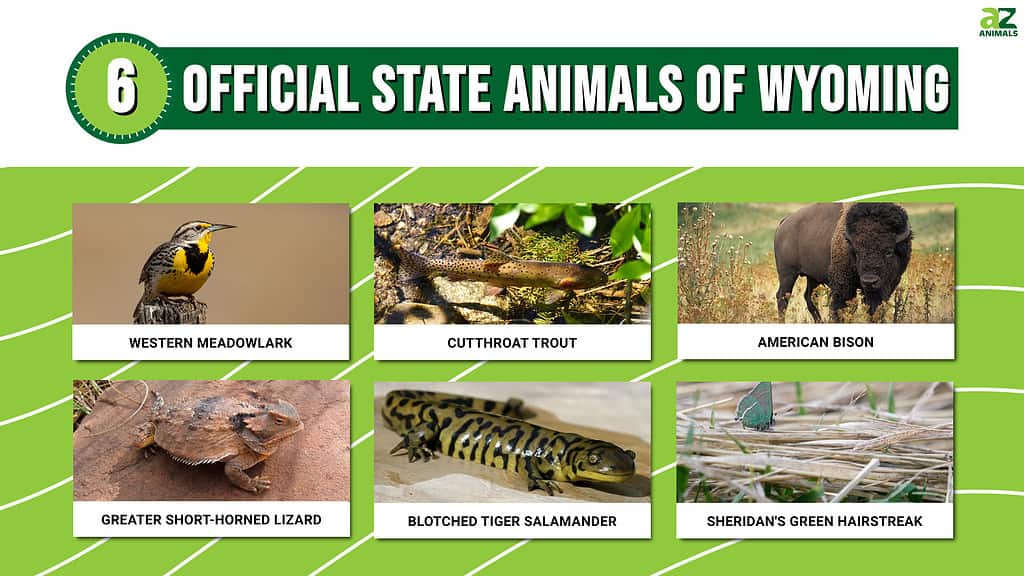
Wyoming is an exciting state for people who are interested in wildlife. It is the 10th-largest state in the U.S., with over 18 million acres of public land. Despite its massive size, only about 576,851 people live in the state. Wyoming is home to two iconic national parks, Yellowstone and Grand Teton. The landscape of Wyoming is vast and varied. In Western Wyoming, where Yellowstone and Grand Teton National Parks are located, the Rocky Mountains rise high above sea level and much of the land is forest. However, Eastern Wyoming is a part of the High Plains, a vast and flat landscape with few trees. Due to Wyoming’s vast and diverse landscape, it is home to many animal species. Six of these species are the official state animals of Wyoming.
Wyoming has an official state bird, fish, mammal, reptile, amphibian, and butterfly. This guide explores each of these species, including their habitat, behavior, and interesting facts about them. Let’s find out what the official state animals of Wyoming are!
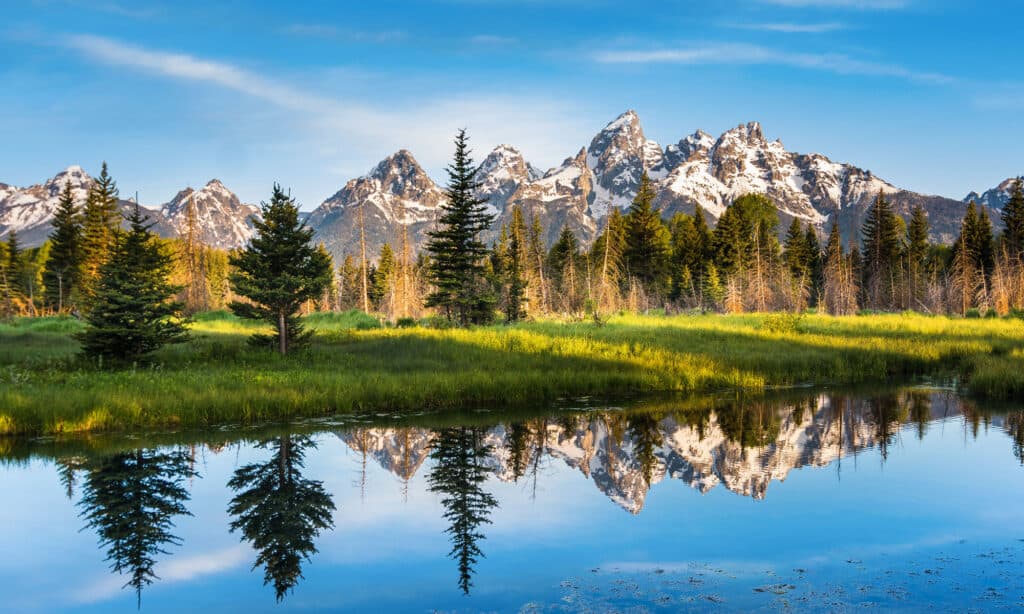
Western Wyoming’s geography features the Rocky Mountains and several large rivers.
©Pat Tr/Shutterstock.com
Wyoming State Bird: Western Meadowlark (Sturnella neglecta)
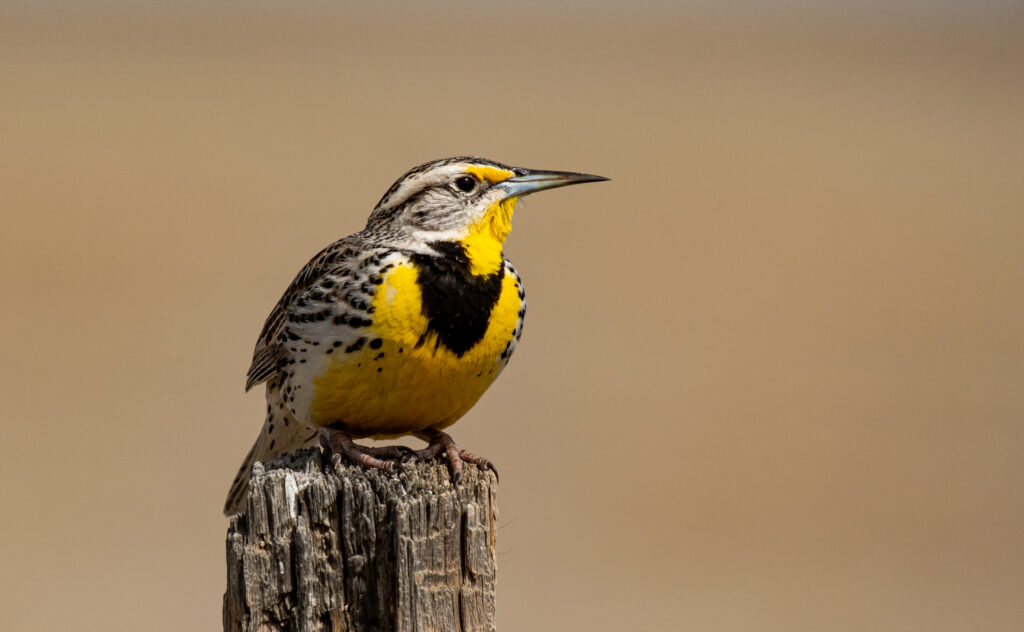
The western meadowlark has a beautiful, flute-like call that is easily recognizable.
©Kerry Hargrove/Shutterstock.com
Wyoming’s official state bird is the western meadowlark. Western meadowlarks became the official state bird on February 5, 1927, making them the first official state animal of Wyoming. Wyoming was also the first of six states to declare the western meadowlark as their official state bird. Despite the “lark” in its name, the western meadowlark is actually a member of the blackbird family, Icteridae. Wyoming is a part of the breeding range of the western meadowlark. These birds nest on the ground in grasslands and are therefore vulnerable to mowing operations. Many of Wyoming’s western meadowlarks migrate south during the harsh winters. Their return marks the beginning of spring in Wyoming. Western meadowlarks have a beautiful, flute-like call that they sing throughout the spring and summer.
The western meadowlark’s beautiful call is a big reason for Wyoming’s adoption of it as its state bird. In 1926, an eighth-grade student named Lewis Freudenthal wrote an essay that said the western meadowlark has one of the most beautiful calls in Wyoming. He also remarked that it is the first bird call heard in the spring. Lewis Freudenthal’s essay made its way into the newspapers and the cause eventually rose all the way to the state senate. The son of this eighth-grade student is Dave Freudenthal, who was a state senator from 2003 to 2011.
Wyoming State Fish: Cutthroat Trout (Oncorhynchus clarki)
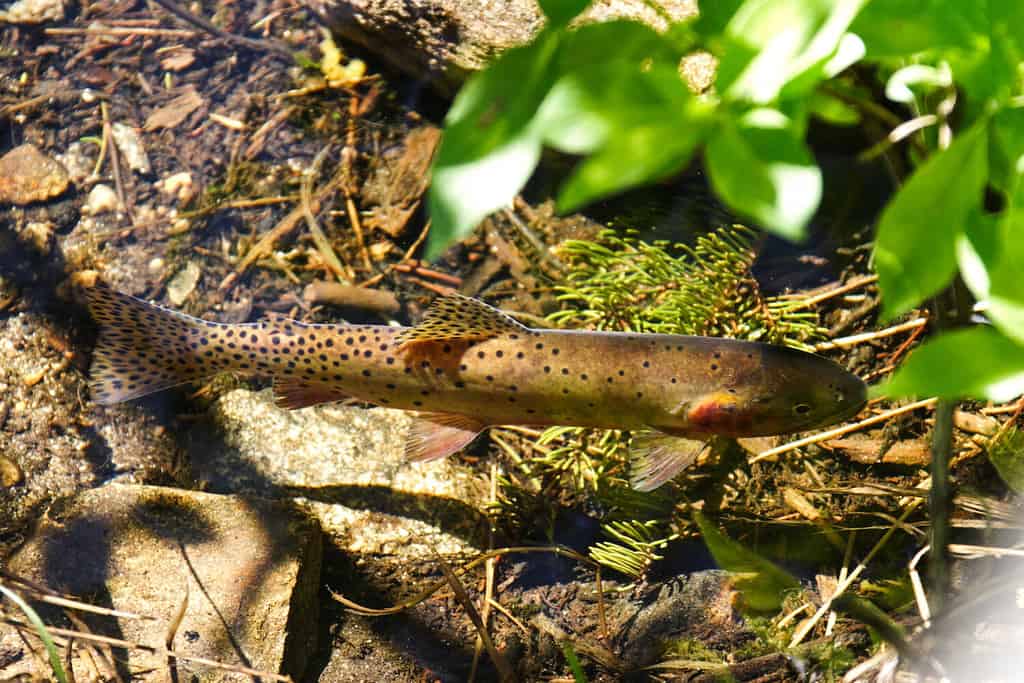
The Westslope cutthroat trout is the rare subspecies of cutthroat trout in Wyoming.
©Gregory Simpson/Shutterstock.com
The official state fish of Wyoming is the cutthroat trout. Cutthroat trout became the official state fish on February 18, 1987. Although there are now many different species of trout in Wyoming, the cutthroat trout is the only native species. The name cutthroat comes from an orange marking on the fish’s lower jaw. Clark, part of the fish’s scientific name, comes from William Clark of the famous Lewis and Clark. Wyoming is home to six subspecies of cutthroat trout. These subspecies are the Bonneville, Colorado River, Snake River, Yellowstone, and Westslope cutthroat. The Westslope cutthroat is the rarest and currently exists in only three percent of its historical range. In Wyoming, it can only be found in the upper northwest corner of the state, mainly in Yellowstone National Park. The cutthroat trout is a popular species for Wyoming anglers, and fly fishing is a common way to fish for them.
Wyoming State Mammal: American Bison (Bison bison)
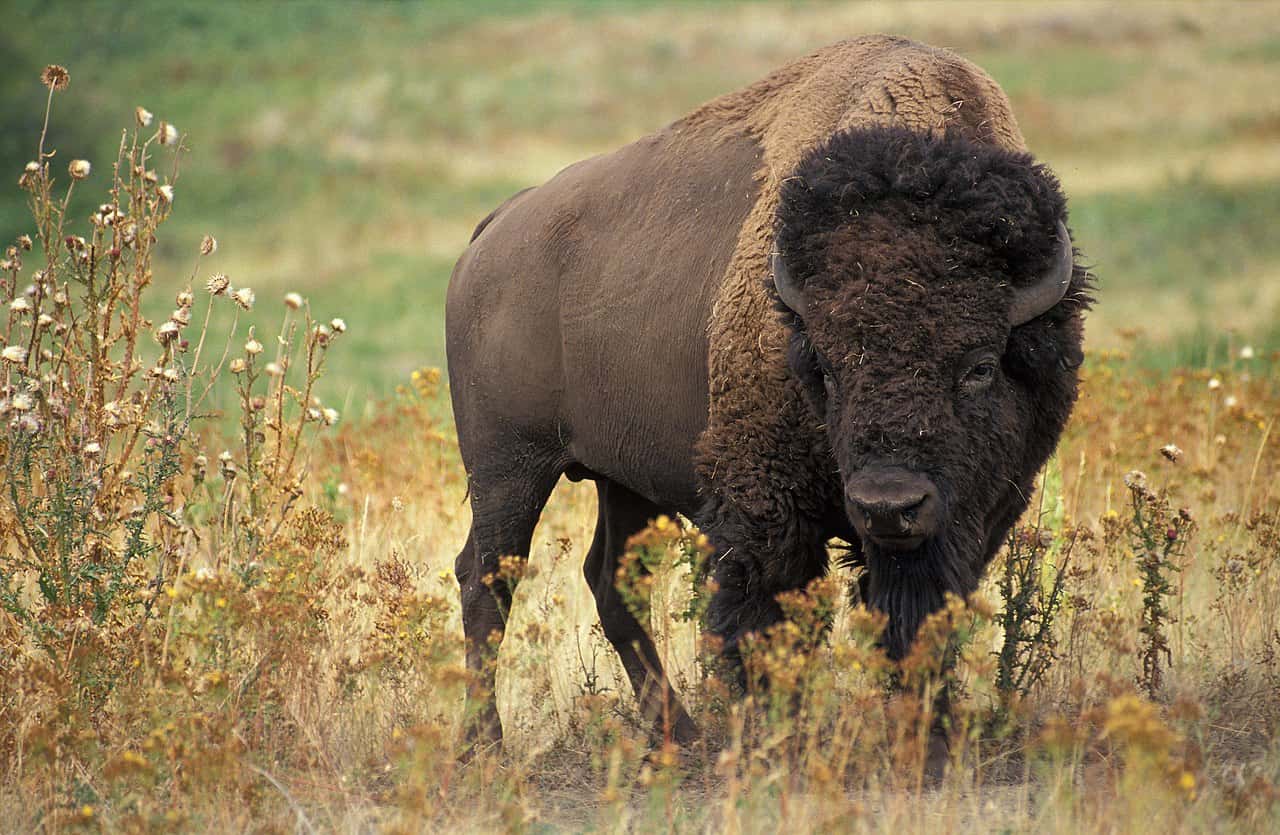
Hunting and commercial slaughter nearly caused the American bison to go extinct.
©Jack Dykinga, Public domain, via Wikimedia Commons – Original / License
Wyoming’s official state mammal is the American bison. The American bison became Wyoming’s official state mammal on February 23, 1985. Bison are also the official mammal of the United States. Although many people refer to these animals as buffalo, that is a misnomer. True buffalo species live in Asia and Africa. The American bison’s historical range includes most of the lower 48 U.S. states and extends north into western Canada and Alaska. Wild American bison live in prairies, plains, and river valleys. There are two subspecies of American bison, the wood bison (Bison bison athabascae) and plains bison (Bison bison bison). The best place to see American bison is in Yellowstone National Park, which has the largest herd of wild American bison. While American bison were wiped out and later re-introduced in most of the United States, they have lived in Yellowstone continuously since prehistoric times.
Wyoming State Reptile: Greater Short-Horned Lizard (Phrynosoma hernandesi)
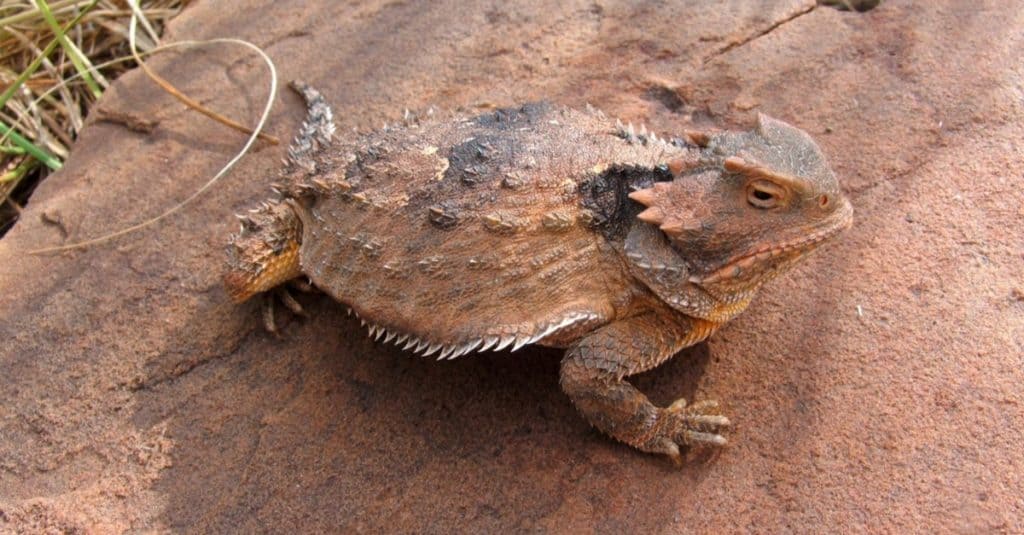
Greater short-horned lizards are able to survive colder temperatures than other
horned lizard
species.
©Matt Jeppson/Shutterstock.com
The official state reptile of Wyoming is the greater short-horned lizard. The greater short-horned lizard became Wyoming’s official state reptile on February 18, 1993. “Horned toad” is a common name for these animals, but that is inaccurate. Toads are amphibians while lizards are reptiles. Greater short-horned lizards are found only in western North America. Their habitat is prairie and mountains, in rocky or sandy soil. Greater short-horned lizards are predators that mainly hunt insects. These lizards are also prey to coyotes, hawks, and snakes. However, greater short-horned lizards have an amazing way to defend themselves against predators. When threatened, these lizards can shoot blood out of their eyes. Greater short-horned lizards are one of the few species of reptiles that have live births. There can be up to 30 babies in a litter of greater short-horned lizards. The babies are able to care for themselves within hours of their birth.
Wyoming State Amphibian: Blotched Tiger Salamander (Ambystoma mavortium melanostictum)
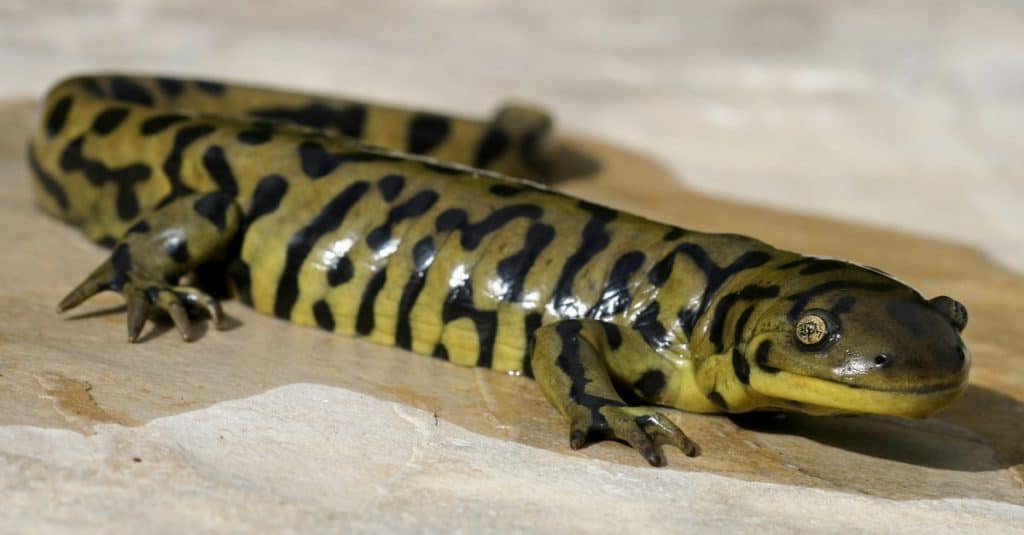
The blotched
tiger
salamander is a nocturnal predator.
©Ryan M. Bolton/Shutterstock.com
Wyoming’s official state amphibian is the blotched tiger salamander. The blotched tiger salamander became Wyoming’s official state amphibian on February 19, 2019. It is one of the five subspecies of the barred tiger salamander (Ambystoma mavortium). Three of the barred tiger salamander subspecies live in Wyoming. Blotched tiger salamanders exist all over the state of Wyoming at elevations under 10,000 feet. They can survive in a variety of habitats, including forests and grasslands, but they require water for breeding. Blotched tiger salamanders lay their eggs in water, and the young salamanders live in water. In their adulthood, these salamanders mostly live on land. The blotched tiger salamander is one of the largest North American species, able to grow up to 12 inches. There are two forms of blotched tiger salamanders, typical and cannibalistic. The cannibalistic form has a larger head and teeth that allow them to eat larger prey.
Wyoming State Butterfly: Sheridan’s Green Hairstreak (Callophrys sheridanii)

Sheridan’s green hairstreak is a small and tail-less butterfly species.
©Taxomony/Shutterstock.com
The official state butterfly of Wyoming is Sheridan’s green hairstreak. Sheridan’s green hairstreak became Wyoming’s official state butterfly on February 26, 2009. There are six subspecies of Sheridan’s green hairstreak. This butterfly lives in higher elevations, from 6,000 to 10,000 feet above sea level. Sheridan’s green hairstreak butterflies eat sulfur flowers, a kind of wild buckwheat. These butterflies live in places where sulfur flowers grow. Sheridan’s green hairstreak is the first butterfly to emerge in spring in Wyoming. They can be seen from March to June. Sheridan’s green hairstreaks are shades of dark brown on the top side of their wings and a bold green on the underside.
The legislation that declared Sheridan’s green hairstreak Wyoming’s official state butterfly was signed into law by Dave Freudenthal in 2009. Dave is the son of Lewis Freudenthal, the eighth-grade student whose 1926 essay played a key role in the western meadowlark becoming Wyoming’s official state bird.
Summary of the 6 Official State Animals of Wyoming
| State Animal | Species | |
|---|---|---|
| 1 | Western Meadowlark | Official State Bird |
| 2 | Cutthroat Trout | Official State Fish |
| 3 | American Bison | Official State Mammal |
| 4 | Greater Short-Horned Lizard | Official State Reptile |
| 5 | Blotched Tiger Salamander | Official State Amphibian |
| 6 | Sheridan’s Green Hairstreak | Official State Butterfly |
The photo featured at the top of this post is © iStock.com/Jillian Cooper
Thank you for reading! Have some feedback for us? Contact the AZ Animals editorial team.







